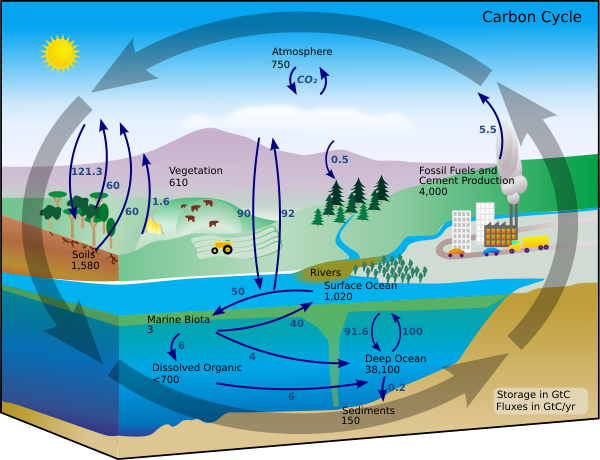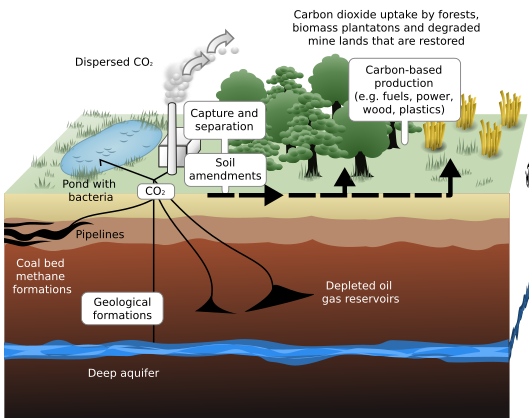AQA Specification focus:
‘Factors driving change in carbon stores: photosynthesis, respiration, decomposition, combustion, carbon sequestration, weathering.’
AQA A-Level Geography students must understand how various physical and biological processes influence the magnitude of carbon stores across Earth's systems.
Major Processes Driving Changes in Carbon Stores
Carbon stores exist in the lithosphere, biosphere, hydrosphere, cryosphere, and atmosphere. The carbon cycle involves transfers between these stores, and the processes that drive these transfers are central to understanding spatial and temporal variations in carbon levels.

This diagram depicts the global carbon cycle, showing how carbon moves annually (in gigatonnes) between atmosphere, vegetation, soils, oceans and fossil-fuel reservoirs; it highlights both natural fluxes (blue arrows) and anthropogenic inputs (e.g. 5.5 GtC/yr from fossil fuel combustion). Source
Photosynthesis
Photosynthesis plays a key role in removing carbon dioxide from the atmosphere and storing it in the biosphere.
Photosynthesis: The process by which green plants and some other organisms convert carbon dioxide and water into glucose and oxygen using sunlight.
During photosynthesis, atmospheric CO₂ is absorbed by plants and converted into organic matter. This reduces atmospheric carbon and increases carbon in the biosphere.
Occurs primarily in terrestrial vegetation and marine phytoplankton.
Most active during growing seasons in temperate and tropical biomes.
Rate is influenced by sunlight, temperature, and CO₂ concentration.
Respiration
Respiration counterbalances photosynthesis and leads to the release of carbon back into the atmosphere.
Respiration: The process by which organisms convert organic molecules (like glucose) into energy, releasing carbon dioxide and water.
Undertaken by plants, animals, fungi, and microbes.
Increases at night (when photosynthesis stops) and in warm, moist conditions.
Contributes to the cycling of carbon between the biosphere and atmosphere.
Decomposition
Decomposition transfers carbon from the biosphere to both the atmosphere and the soil.
Decomposition: The breakdown of dead organic matter by bacteria, fungi, and other decomposers, releasing carbon dioxide and methane.
Occurs rapidly in warm, moist environments and more slowly in cold, dry, or anoxic conditions.
Some carbon becomes soil organic carbon (longer-term store).
Releases CO₂ or CH₄ into the atmosphere, depending on oxygen availability.
Combustion
Combustion refers to the burning of organic material, releasing large quantities of carbon dioxide.
Combustion: A chemical reaction involving the burning of organic material (biomass or fossil fuels), producing carbon dioxide and water.
Occurs naturally (e.g. wildfires) and anthropogenically (e.g. burning fossil fuels).
A major contributor to atmospheric CO₂ increases due to human activity.
Transfers carbon from biosphere/lithosphere to atmosphere.
Wildfires, in particular:
Rapidly oxidise large amounts of organic carbon.
Can be natural (lightning) or human-induced.
May also stimulate regrowth, encouraging future carbon uptake via photosynthesis.
Carbon Sequestration
Carbon sequestration refers to the long-term storage of carbon in various carbon sinks.
Carbon sequestration: The process of capturing and storing atmospheric carbon dioxide to reduce its presence in the atmosphere.
There are two types:
Natural sequestration:
In forests (biomass and soils).
In oceans (carbon dissolved in water and stored in marine organisms or sediments).
Artificial sequestration:
Technologies such as carbon capture and storage (CCS).
CCS captures emissions from power stations and stores them underground in geological formations.
Carbon sequestration is critical for climate regulation and mitigation of anthropogenic emissions.

A schematic of terrestrial and geological CO₂ sequestration, showing how emissions from a power station can be captured and stored in soils, biomass or deep underground formations; note the pond with bacteria and soil amendments, which illustrate natural enhancement methods. Source
Weathering
Weathering contributes to long-term carbon transfers from the atmosphere to the lithosphere.
Weathering: The breakdown of rocks and minerals at Earth's surface through chemical, physical, and biological processes.
In the context of the carbon cycle, chemical weathering is particularly significant:
Involves carbonic acid (formed from CO₂ and water) reacting with carbonate or silicate rocks.
Produces dissolved ions that are transported via rivers to oceans and deposited as carbonate sediments.
This leads to:
Long-term carbon storage in the lithosphere.
A gradual drawdown of atmospheric CO₂.
Biological weathering also plays a role:
Roots secrete organic acids that break down minerals.
Lichens contribute to rock decomposition.
Summary of Process Impacts on Carbon Stores
Each process contributes differently to the fluxes of carbon between stores:
Photosynthesis: Draws down atmospheric CO₂, builds biomass.
Respiration: Returns CO₂ to the atmosphere from organisms.
Decomposition: Releases CO₂ or CH₄; enriches soils.
Combustion: Rapid oxidation of carbon to the atmosphere.
Sequestration: Stores carbon long-term in terrestrial or oceanic sinks.
Weathering: Transfers CO₂ from the atmosphere to the lithosphere over geological timescales.
These processes interact continuously and operate at multiple spatial and temporal scales. Understanding them is essential for evaluating carbon balance and predicting climate trends under changing environmental conditions.
FAQ
Temperature plays a major role in regulating decomposition rates. Warmer conditions typically increase microbial activity, accelerating the breakdown of organic matter and releasing more CO₂ or CH₄ into the atmosphere.
In colder or permafrost regions, decomposition is much slower due to reduced microbial activity. When such areas thaw, decomposition can intensify suddenly, releasing significant stored carbon.
Soils act as both temporary and long-term carbon stores. During decomposition, some carbon from organic matter is incorporated into the soil as humus or stable organic carbon.
Key roles of soil in carbon storage:
Holding organic carbon from plant litter and roots
Supporting microbial activity that controls fluxes to the atmosphere
Acting as a slow-release reservoir, particularly in undisturbed ecosystems
Chemical weathering removes atmospheric CO₂ over geological timescales. Carbonic acid formed from CO₂ and rainwater reacts with rocks like limestone or silicate minerals, forming dissolved bicarbonates.
These products:
Are transported to oceans via rivers
Precipitate as marine carbonates, locking carbon into sedimentary rocks. This process regulates atmospheric CO₂ and contributes to long-term climate stability.
Changes such as deforestation or urbanisation disrupt natural carbon cycles. Removing vegetation reduces the biosphere’s capacity for photosynthesis, while decomposition and combustion of biomass increase atmospheric CO₂.
In addition:
Soil disturbance can increase respiration from microbes
Replacement with agriculture may reduce long-term storage and intensify seasonal variation
Natural combustion, such as wildfires, occurs periodically and often forms part of ecosystem renewal. Though it releases CO₂, regrowth can partially offset emissions.
Anthropogenic combustion, such as fossil fuel burning:
Adds carbon that has been locked for millions of years
Lacks offsetting regrowth
Has contributed to significant atmospheric CO₂ increases over the last two centuries
These differences are critical in understanding human influence on carbon balance.
Practice Questions
Identify and briefly explain two processes that increase the amount of carbon in the atmosphere. (3 marks)
Mark Scheme:
1 mark for each correct process identified (max 2)
+1 mark for one clear explanation linked to one process
Combustion – burning fossil fuels or biomass releases CO₂ into the atmosphere. (1 mark for identification, 1 mark for linked explanation)
Respiration – releases CO₂ when organisms break down glucose for energy. (1 mark)
Explain how both natural and human processes influence the size of carbon stores in the biosphere and atmosphere. (6 marks)
Mark Scheme:
Level 1 (1–2 marks): Basic statements with limited detail or vague understanding.
Level 2 (3–4 marks): Some clear explanation of processes with partial linkage to carbon stores.
Level 3 (5–6 marks): Clear and developed explanation of multiple processes with explicit links to how they affect the size of carbon stores.
Indicative content:
Photosynthesis decreases atmospheric CO₂ by transferring it to biomass (biosphere).
Respiration increases atmospheric CO₂ as organisms release carbon.
Decomposition transfers carbon from dead organisms to soil and atmosphere (CO₂/CH₄).
Combustion of fossil fuels or wildfires releases large amounts of carbon to the atmosphere.
Carbon sequestration (natural and artificial) stores CO₂ in vegetation or geological formations, reducing atmospheric levels.

